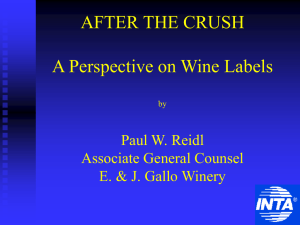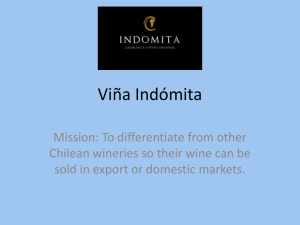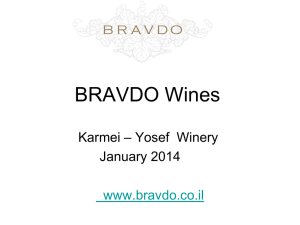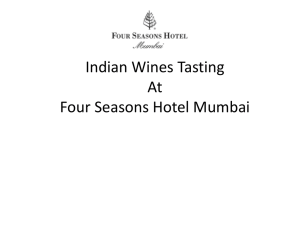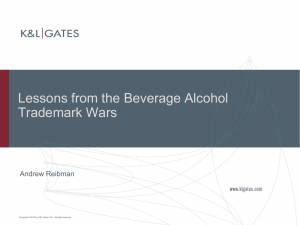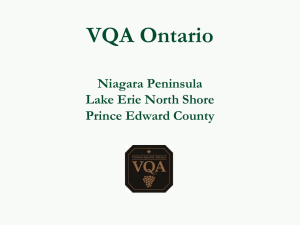Wine: A Poster Child for Globalization
advertisement
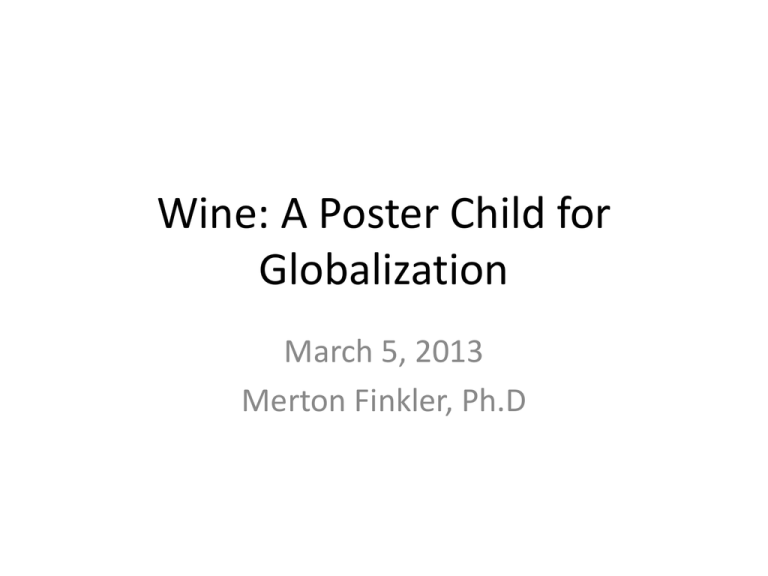
Wine: A Poster Child for Globalization March 5, 2013 Merton Finkler, Ph.D Scottish Highland Cattle in California Overview • The Past – Wine options circa 1970 – Limited options, high quality wine was very expensive • The Present – Today’s wine options – Numerous options for high quality wine available • The Future – Conjectures about wine in 2050 – Product, process, and price will evolve – Will most wine be delivered in barrels or botas, not bottles? – Will global warming make Wisconsin the wine capital of the US? Globalization: It’s a Flat World • Globalization defined – Specialization: production is divided into component parts & produced where cheapest • Grape farming • Wine making • Distribution and sales – Consolidation: scale economics and lowest cost dictate the character of the supply chain & production – Result: more choice, better value – Wine comes from “Chateau Cash Flow” Why is Wine a Poster Child for Globalization? • Changes in character of the product, the process of production and delivery and prices are driven by worldwide competition. • Evolution from a niche product with few identifiable segments to a continuum of products with good quality available at a good price in most places • Globalization brings a world of exciting wine experiences, but it also unleashes market forces that threaten to overwhelm the “soul” of wine. Terroirism: The Response to Globalization • Terroirism claims that wine has a unique character based on where it is produced. • Soil+ Climate+ Area = Mystique • Wine’s “soul” comes from the physical attributes of the physical locale and the personality of that local culture Wine and the Movies • Bottle Shock – California wines surprise French experts at a 1976 competition • Sideways- wine culture: merlot (for the masses) vs. pinot noir (for the elite) • Mondovino: The Revenge of the Terroirists – Fear of McWine movement – Importance of authenticity: appellation d’origine controllee – Reject global wine makers/consultants Key Resources • Wine Wars: The Curse of the Blue Nun, the Miracle of Two Buck Chuck, and the Revenge of the Terrorists (Michael Veseth) • www.wineeconomist.com • The American Association of Wine Economists which produces the Journal of Wine Economics http://www.wine-economics.org/ • The Box: How the Shipping Container Made the World Smaller and the World Economy Bigger (Marc Levinson) • Elliott Morss – Global Finance http://www.morssglobalfinance.com/judgments-ofparis-princeton-and-lenox-part-3/ Wine – Circa 1970 • Most wines came from France, Germany, or California and were specific varietals – e.g., chardonnay or cabernet sauvignon • Vintners: grew grapes, made wine, and sold it. • The wine that came in a box was nasty and brutish. • Blends were white or red mix of left overs – marketed as chablis or burgundy • There were 579 wineries in the US – At least 1 winery in only 34 states – Wisconsin had 5 wineries • State Liquor Board monopolies controlled wine sales – Washington until 1969 treated California wine as foreign – Result: Poor quality & high prices Wine circa 1995 • • • • Number of US wineries tripled to 1,817 All but 3 states had at least one winery Wisconsin had 13 wineries Few wine bars – concentrated in California and the Northeast • Blending of grapes for improved quality was still relatively rare. Wine 2010 – US Background • There were 6,672 wineries in the US in 2010 (10 x 1975) • All fifty states had at least 2 wineries ; 41 states had at least 10 wineries • Wisconsin had 65 wineries (13x – 1975) • Some wine companies – e.g. Castle Rock (25th largest wine seller in US) - own no vineyard or winery. • 35% of wine consumed in the US is imported Effects of Globalization • Specialization means grape farming, wine making, and wine selling done by different organizations connected by a supply chain • Global wine makers common – Michel Rolland • One result: Two Buck Chuck – One Euro Aldi • Another result: Bottling and wine making need not take place near where grapes are grown; thus as Veseth puts it “Sell Local, Source Global” • Third result: Much wine is shipped in sealed blatters inside boxes and bottled by distributors for worldwide sale. (50% of New World exports) This Wine Blatter Contains 24,000 liters or 32,000 bottles of enjoyment Blends are Abundant and of Decent Quality • Some wineries give specific percentages – Meritage (Sterling) – 57% Cab S, 37% Merlot, … – 80/20 (Stones Throw) • Some just identify the grapes – Cellar #8 from Asti Winery notes 8 varietals • Some just say it’s a blend – Kendall Jackson’s Summation – grapes originally from Loire and Rhone Valleys – sells for price similar to its Chardonnay. • Yellowtail – 650 different sources Consolidation World Wine Production (2010) Most grapes grown between 30th and 50th latitudes Country Production (million % of World Total liters) France 4,627 17.5% Italy 4,580 17.4% Spain 3,610 13.7% United States 2,653 9.9% Argentina 1,625 6.2% Australia 1,073 4.1% 425 1.6% China Vineyard Cost per Hectare • US and Europe - $50,000 per hectare for land suitable for vineyards ($20,000/ acre) • Established vineyards – up to $750,000/hectare • Argentina – land suitable - $10,000/ hectare and established vineyards– as low as $35,000/hectare • Languedoc – half million acres of vines over 30k wine makers, much of it subsidized by the EU and distilled into industrial alcohol • Conclusion: Given quality, it’s hard to compete with wine from Argentina, Australia & Chile World Wine Consumption (2010) Country Liters per capita Total Consumption World Share France 45.70 2,943 million 12.5% Italy 42.15 2,449 million 10.4% Spain 26.16 1,059 million 4.5% 9.42 2,893 million 12.3% Argentina 23.74 971 million 4.1% Australia 24.93 531 million 2.3% 0.69 923 million 3.9% United States China Gaps – Production minus Consumption Country Gap % of Production France 1.684 million 36.3% Italy 2,131 million 46.5% Spain 2,551 million 70.7% United States - 240 million - 9.0% Argentina 654 million 40.2% Australia 102 million 9.5% China - 498 million -117.2% Today’s Wine Market • Project Genome surveyed 10,000 consumers • 70-70-70 rule • 3 containers – bag, screw cap with plastic bottle and traditional glass and cork. • Terroirism in America • A variety of niches: Biodynamics, spend the day, get married, bring the kids There are 6 key premium wine consumer segments, each with its own distinct wants and needs. ($8+ / bottle) 21 22 The 70 – 70 – 70 Rule • 70% of wine sells for less than $12 / bottle • 70% of wine is consumed within 3 hours of purchase • 70% of wine price comes from the packaging • Implication: Tomorrow’s wines will focus on the cheap delivery of good wine to drink on the day of purchase American Viticultural Areas • Terroirism has come to the US • Specific vineyards are identified for reserve wines. • There now exist many AVAs in the US • On April 23, 2012, Wisconsin Ledge AVA created– • http://www.escarpmentnetwork.org/pdf/Exhibit1_NEWineriesMap_Nov2009.pdf • 12th largest AVA in the US, 320 acres of vineyards, 16th largest number of wineries in AVA • Others include 16 AVA w/in the Napa Valley (CA) • Branding idea: unique geography, soil, & climate Wisconsin AVAs Napa Valley AVAs The Future • Traditional bottles w/ cork will be the exception – Heavy and expensive to ship – 5% spoilage rate makes it unattractive – No major difference for “tonight’s” wine • Wine Cube California Chardonnay (High ratings) • Yellow Jersey Pinot Noir- lightweight, shatterproof, oxygen-barrier retains quality, 50% less greenhouse gas, easily recycled www.yellowjerseywine.com • Tetrabag – many 500 ml examples –California Rabbit • Stelvin closures – screw tops keep out air. • Wine on tap in oak barrels will become common Wine Cube More about the Future • Blending will continue – Use the best grapes to make the best tasting wine • High yield grape farms will dominate the market. • China will be a big player on both the production and consumption side. It has a long way to go from Great Wall Cabernet • US will import at least 50% of its wine as opportunity cost of growing grapes will cause switch to almonds and pistachios Niche Markets • Family Wineries – V Sattui • Biodynamic Wineries – Benzinger • Grapes grown from specially created vines that make them climate consistent – Ledgestone’s Frontenac • “Fun” places – wine is part but not the central story – Lautenbach’s Orchard Country Market and Winery • Pro Football’s Finest V Sattui – A Place to Spend the Day Benziger’s Biodynamics http://www.youtube.com/watch?feature=player_embedded&v=qa2ElPaiY2A Ledgestone – Made in Wisconsin Orchard Country Market and Winery – Door County Cherries Twenty Four – Charles Woodson Modern Technology and Opus One • Presenting at WineFuture Hong Kong 2011, David Pearson of Opus One said, “Starting with our 2008 vintage, we have an NFC tag on each bottle under the back label, which connects consumers to a video of our winemaker. Now we envision adding an eProvenance sensor inside each case to monitor the temperature for 15 years, allowing consumers with an NFC phone to read the entire temperature history with one click. The potential to connect with our consumers and to safeguard their wine is tremendous.” Make the Right Wine Choice – Near Field Communication http://www.youtube.com/watch?v=yK9v4YMMyLY Wisconsin – US Wine Capital? • Global Warming means that production between the 30th and 40th parallel will be more difficult • More wine can be produced between the 40th and 50th parallel. More northern AVAs • Parallel 44 winery in Kewaunee notes it has many characteristics similar to Bordeaux and Tuscany (also at 44th parallel) • Perhaps Washington state is a better bet than Wisconsin - @12 million cases per year Washington’s 13 AVAs

